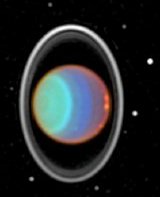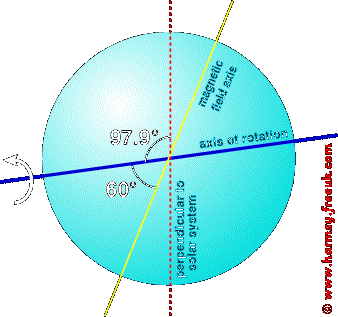
 |
Uranus - tilted extremes |
|
| |
 Vital StatsFirst DiscoveryUranus is barely visible to the naked eye. As a result, it was not discovered until 1781 by William Herschel. He used a powerful reflecting telescope he had made himself, having improved on Isaac Newton's earlier designs.For years, astronomers observed slight problems with its orbit, which did not match mathematical predictions. They assumed there was a more distant planet pulling it off course. The hunt began with predictions of where the body (Neptune) could be... Tilted ChaosOne feature which puts the planet in a class of its own is the tilt of its rotational axis at 97·9° to its orbital plane:  Its magnetic field is further offset, leading to a complex interaction between the solar wind and this planet.  View/Sign Guestbook |
Ringed Ice Giant
Minor moons have been discovered on either side of the outermost rings. They perform a shepherding action similar to that seen in Saturn's ring system. Far OutDue to its great distance from the Sun, and the fact that it has very little internal heating, the planet's temperature is very low. At the top of the atmosphere it is so cold that methane (CH4) condenses above the clouds. There is a considerable magnetic field around the planet which is offset from the centre, and is inclined at 60° to the rotational axis (as shown in the previous diagram). This magnetic field extends far out into space and envelopes all the Uranian satellites. Probing UranusLittle was known about Uranus until its encounter with Voyager 2 in 1986. Voyager was able to return to Earth highly detailed images of each of the major satellites, and also revealed the presence of ten which were previously unknown. Voyager 2 SchematicsThe Hubble Space Telescope (H.S.T.) took the top photograph in infrared light. Clearly visible are its eight main moons, cloud detail (false colour) and the faint rings. Click for larger image. |
|
Sun | Mercury | Venus | Earth | Moon | Mars | Asteroids | Jupiter | Saturn | Uranus | Neptune | Pluto | X | Kuiper | |